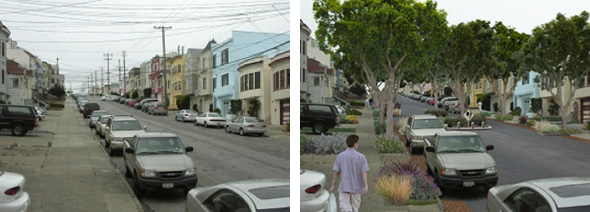When San Franciscans voted to fix crumbling streets by approving Proposition B, they also approved nearly $90 million for pedestrian, bike, and transit projects. It will give certain Muni lines the power to change traffic signals, and pay for sidewalk improvements and bike lanes.
“Prop B gives us the opportunity to really catch up on our streets—not just fixing potholes, but actually making the streets better from an urban design perspective,” said Gabriel Metcalf, executive director of SPUR.
Elizabeth Stampe, executive director of Walk SF, said the value of these projects will make the borrowing worthwhile. “These are exactly the kind of investments that it makes sense to use a bond for,” she said. “They are long-term improvements that will improve the safety and walkability of our streets.”
Much of the money is assigned to specific projects, but the largest chunk—$50 million—will be divvied up through a political process. This money could be used to stripe bike lanes, plant trees, install new lights, or otherwise improve streetscapes. Planners will be holding meetings in 2012 to determine where this pot of funding should go.
“I think the biggest opportunities for pedestrian improvements are on the neighborhood commercial streets,” Metcalf said. “These are the central places within every neighborhood in the city, the places where activity is concentrated and where we want to create a truly comfortable and inviting public realm.”
The San Francisco Bicycle Coalition will be advocating for money to go to dedicated bike lanes, said Executive Director Leah Shahum. “They are proven to draw more people onto bikes, improve safety, and connect neighborhoods with real, low-cost, bang for your buck,” she said, before reeling off a list of streets where a little money could go a long way: Masonic Avenue, Jefferson Street near Fisherman’s Warf, Polk Street, the Embarcadero, Ocean and Geneva Avenues. “This is just a partial list,” she said. “Obviously there’s not enough money to do everything."
The funding has the potential to save lives. More than half of pedestrian deaths and severe injuries occur on just 6.7 percent of streets by length, noted Tom Radulovich, head of Livable City. “I don’t want to miss that opportunity. As they move through the city, any time the resurfacing touches on of that 6.7 percent, we should be making improvements.”
The rest of the $90 million, beyond the $50 million for streetscapes, breaks down as follows:
- $20.3 million for Muni signal priority: Stoplights will be programmed to sense approaching Muni vehicles and turn green, said Municipal Transportation Agency representative Paul Rose. “It will give signal priority to our fleet so that when they come to a stoplight they get through faster,” he said. “It will cut travel times and prevent bunching up.” Rose said Muni has not determined which routes will receive this technology first.
- $14 million for pedestrian curb cuts: Pays for the construction of 1,767 new curb ramps to make sidewalks more accessible to wheelchairs, strollers, and those using walkers. Spots that people with disabilities have identified will get top priority.
- $8 million for sidewalk improvements: Flattens sidewalks cracked by age or tree roots.
- $7.3 million for seismic retrofits: This will go to fix concrete that has buckled with movement, and to repair structures (bridges, tunnels, retaining walls, and stairs) that could fail in an earthquake.
Enjoy the Thanksgiving weekend. Streetsblog San Francisco will be back publishing on Monday.





